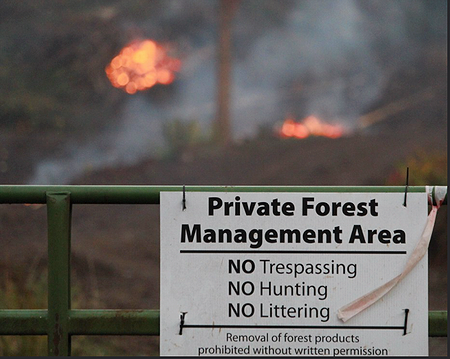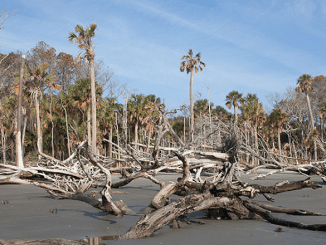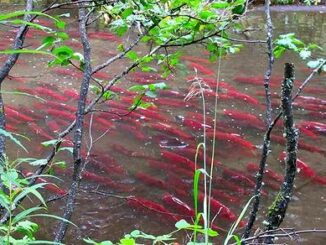
SALEM, Oregon, November 14, 2021 (ENS) – “This is truly an exciting time to be a part of the Oregon forest sector,” said David Bechtold, representative of a coalition of forest companies. “We’re extremely proud to have started a process for more constructive engagement on forest policy issues.”
An agreement among more than two dozen representatives of conservation, timber, and fishing organizations that outlines breakthrough changes to forest practices on 10 million acres of private forested land was announced October 30 by Oregon Governor Kate Brown.
Calling it a “historic agreement,” Governor Brown said this is “a perfect example of the Oregon Way – coming together at the table to find common ground, to the mutual benefit of us all.”
“Together, this agreement will help to ensure that Oregon continues to have healthy forests, fish, and wildlife, as well as economic growth for our forest industry and rural communities, for generations to come,” said Brown.
The agreement was reached after nearly 10 months of negotiations that began on January 12. The proposal entails substantial updates to Oregon’s Forest Practices Act, an act ratified by Oregon’s legislature in 1971 with adaptability in mind so that the legislation could stay current as circumstances and scientific knowledge advanced.
The changes to the Forest Practices Act agreed to by the parties will be brought before the Oregon Legislature.
The reforms to the Forest Practices Act will be reviewed by NOAA Fisheries and the U.S. Fish and Wildlife Service who will decide whether it has met the standards for a statewide Habitat Conservation Plan under the Endangered Species Act, a designation that was aimed for during the negotiations.
Meeting the criteria for a Habitat Conservation Plan would provide more concrete regulation for private landowners and more secure, lasting conservation efforts for specified species under the Forest Practices Act.
The negotiations yielded a framework for:
• Riparian buffers for streams, rivers, and bodies of water;
• Steep slopes protection to minimize erosion and protect habitat;
• An approach moving forward to improve forest roads; and
• A path forward to make adjustments and adaptation to forest practices in the future.
Bob Van Dyk, Oregon Policy Director at Wild Salmon Center said, “We are thrilled to join the governor and timber industry counterparts on a new path for Oregon’s forests and for our organizations.”
“The measures announced today provide significant new protections for our fisheries, for cold clean water, and for the people who rely on these resources,” Van Dyk said.
The new agreement isn’t without criticism. The nonprofit Center for Sustainable Economy, based in Portland, Oregon, raised the concern that the phrase climate change is not even present within the proposal although industrial forest practices are the leading cause of emissions in the state.
The effects of the continuation of these practices could be devastating for wildlife in Oregon, the group warns, although the agreement yielded a path accomodating future changes.

There is a history to this attempt to manage forests on private lands. In February 2020, the opposing sides – the timber industry and conservationists – decided to abandon a controversial, expensive fight for a ballot measure to change forest practices on these lands in favor of a more collaborative bipartisan approach to forestry practice reform.
The sides agreed to participate in a mediated process of up to 18 months with the goal of arriving at a federally approved Habitat Conservation Plan for how private forests should be managed to ensure protection of imperiled species and water resources.
The Private Forest Accord announced October 30 proposes new protections for vulnerable and endangered species and would provide more regulatory and legal certainty for timber companies and small woodland owners about logging on their lands.
The Governor’s Office, mediator Peter Koehler, and Peter Harkema from Oregon Consensus, facilitated as the parties worked toward a deal, reached in late October.
The conservation and fishing side representatives are Bob Van Dyk of Wild Salmon Center, Sean Stevens of Oregon Wild, Chrysten Lambert of Trout Unlimited, Bob Sallinger of Portland Audubon, Joseph Vaile of Klamath Siskiyou Wildlands Center, and Dr. Kelly Burnett of Aquatic Scientist.
Also joining in the agreement are the Beyond Toxics, Cascadia Wildlands, Northwest Guides and Anglers, the Oregon League of Conservation Voters, the Oregon Stream Protection Coalition, The Pacific Coast Federation of Fishermen’s Associations, Rogue Riverkeeper, and Umpqua Watersheds.
For the timber sector, the representatives are Adrian Miller of Rayonier, Diane Meyers of Weyerhaeuser, Cameron Krauss of Seneca Sawmill Company, Heath Curtiss of Hampton Lumber, Eric Geyer of Roseburg Forest Products, and Jim James of Oregon Small Woodlands Association. Also joining in the agreement are Hancock Natural Resource Group, Lone Rock Resources, Greenwood Resources, Campbell Global, Starker Forests, and Port Blakely.
Forest industry representative Bechtold said, “This is a new era that will produce the best outcomes for Oregon’s private forests and the communities that depend on them to provide clean water, recreation, renewable wood products and year-round, family-wage jobs.”
— By Benjamin Seidman
Featured image: Industrial Salvage logging after the 2020 Archie Creek Fire east of Roseburg, Oregon. December 25, 2020 (Photo by Francis Eatherington)
© 2021, Environment News Service. All rights reserved. Content may be quoted only with proper attribution and a direct link to the original article. Full reproduction is prohibited.



